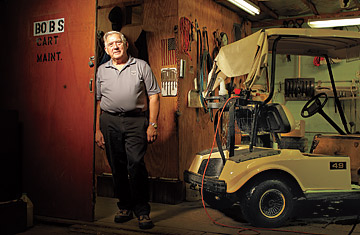
Robert Shively, 68, worked in a chemical plant for 36 years, but that didn't earn him an easy retirement.
(5 of 8)
Under Occidental's old pension plan, he would have gotten a monthly check of about $2,200. More important, he wouldn't have to spend much of his remaining eyesight squinting at CNBC, wondering how he will afford the rest of his life. The pension check would have been guaranteed until he died. "I'm a pretty optimistic guy, but I'm still worried," says O'Neil. "Ten years from now, where am I going to be after I burn through the cash?"
Where 401(k)s Go Wrong
In theory, 401(k)s should provide much more of a retirement cushion than they do. A 2007 study from the National Bureau of Economic Research (NBER) estimated that, on the basis of historical returns, by 2040 the average 401(k) of a near retiree would grow to an inflation-adjusted $451,944. That money, spread over 30 years, could replace at least 50% of the average retiree's income. Add Social Security and even highly paid workers will probably earn more than 80% of their preretirement income. "The only reason these accounts haven't lived up to their potential is that they haven't gotten enough time," says James Poterba, president of the NBER, who co-authored the study.
In practice, 401(k)s haven't been nearly so rewarding. When Boston College's Munnell looked at the returns 401(k)s have actually produced compared with the projections, the difference was sobering. The average 55-to-64-year-old should have a 401(k) balance of $320,000. In fact, at the end of 2007, the average 401(k) of a near retiree held just $78,000--and that was before the market meltdown.
Why don't these accounts amount to much? Munnell found a number of reasons. Some people don't contribute as much as they should--essentially ignoring free money from company matches and tax relief. And, as the original engineers of the 401(k) suspected, the less you earn, the less you are likely or able to contribute. For most employees, the maximum contribution to a 401(k) is $16,000 annually. She found that just 5% of people earning $80,000 to $100,000 maxed out, compared with 30% of those making $100,000 or more.
Additionally, to get the hypothetical higher returns over time and avoid investing disasters, you have to hold a diversified portfolio of stocks and bonds. Many of us don't. Munnell found that 14% of workers held no stocks at all, leading to weaker-than-average returns. On the opposite end, more than a quarter of all 401(k)s were 100% stocks, exposing those accounts to big losses when the market dropped.
Earlier this year, mutual-fund company T. Rowe Price tried to determine the optimum retiree portfolio--the mix of stocks and bonds that would produce the highest returns without the risk of the nest egg running out. To do this, the analysts ran something called a Monte Carlo simulation, which mimics the real-life ups and downs of the market. Most of the time, the market goes up slightly. But some years--ka-pow!--stocks and bonds do spectacularly poorly. What T. Rowe Price found should frustrate anyone who has spent time wondering if 25% of a portfolio should be in international bonds or small-cap stocks. No portfolio is 100% safe from disaster.
